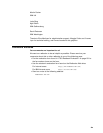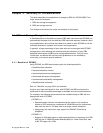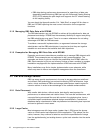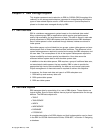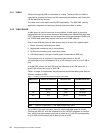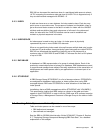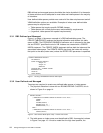Summary of Considerations 7
Installations having these devices could use sequential caching as an installation
option. Installations with a mixture of devices with large, small, or no cache can
benefit from the bypass cache option.
2.2.3 Log Structured File
Devices using the log structured file technique (like the RVA) do not maintain data
location during data updates. For these devices there exists a concept of logical
location of data, independent from the the physical location. The logical location
is used by the device to present the data to the application: the user sees a
contiguous extent on a 3390 volume, while the data is in reality scattered across
the LSF.
A REORG of a DB2 table space provides a logical sequence of records which
could not be corresponding to a physical sequence. This is a function of the
space management of the storage server.
Worrying about reorganizing data to reclaim space extents is now much less
critical with the new disk architecture. REORG does not need to be run in order to
reclaim fragmented space in this case, only to reestablish the clustering (logical)
sequence and the DB2 internal free space. When the DB2 optimizer chooses
sequential prefetch as a valid access path, the storage server detects the logical
sequential access and initiates pre-staging of the logically sequenced tracks into
cache, providing improvement to the I/O response time for the subsequent
prefetch accesses.
2.2.4 RAMAC Architecture
Disk architecture defines each volume in a logical way through tables. These tables
do an effective mapping between the logical view of the volume onto the disk array
with data and rotating parity physical disks. This means that each I/O operation takes
place to or from several physical disks. However, the host still views only the logical
volume topology, and it bases its optimizing and scheduling strategies on this view,
as it used to do with native 3380 and 3390.
2.2.5 SMS Storage Groups
Volume separation is easy when you have hundreds of volumes available. But
this separation is good only if your volumes have separate access paths. Path
separation is important to achieve high parallel data transfer rates.
Without DFSMS, the user is responsible for distributing DB2 data sets among
disks. This process needs to be reviewed periodically, either when the workload
changes, or when the storage server configuration changes.
With DFSMS, the user can distribute the DFSMS Storage Groups among storage
servers with the purpose of optimizing access parallelism. Another purpose could
be managing availability for disaster recovery planning. This can be combined
with the previous purpose by letting DFSMS automatically fill in these Storage
Groups with data sets, by applying policies defined in the automatic class
selection routines.
Changes to the topology of the Storage Group can be managed to minimize the
application outages. This can be done simply by adding new volumes to the
Storage Group, then managing the allocation enablement (opening it on new



